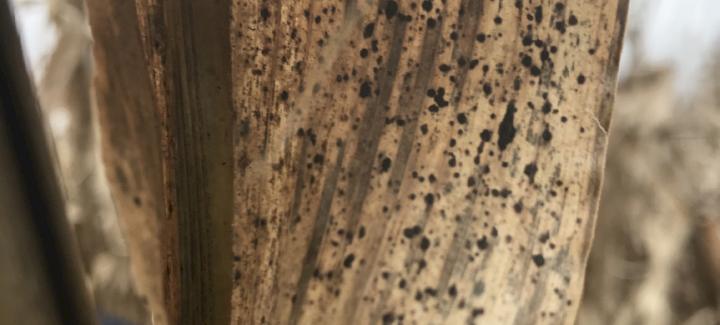
On June 23, Iowa State University Extension and Outreach announced that tar spot has been observed in six counties in central Iowa. Stine agronomists and sales reps have also received reports of suspected tar spot in corn throughout the Midwest and the Eastern Corn Belt. The disease, which was first discovered in the U.S. in 2015 in Indiana, traveled from Central America and Mexico. Since then, it’s moved from east to west and is quickly becoming a concern. The earlier it moves in during the season, the more time it has to spread and lead to yield loss.
Meaghan Anderson, field agronomist for central Iowa at Iowa State University Extension and Outreach, recently sat down with Stine Seedcast host David Thompson to discuss tar spot. In their conversation, which will air on Tuesday, July 18, Anderson notes that the severity of the disease this year will depend on the weather. “We’re certainly setting up to potentially have an issue if the weather does what we are worried it could do.”
The disease thrives in moist environments with moderate temperatures. ISU Extension and Outreach notes, “the daily minimum or the daily mean temperature over the past 30 days was the most strongly correlated with tar spot development and increased severity. Moderately warm (below 70F) mean temperatures increased development and severity.”
How to identify tar spot in corn
Tar spot symptoms are typically observed later in the season during grain fill or around R3 to R6. The fungal disease appears as black lesions on the leaf called stromata. Anderson notes, “Stromata can break open and then they’ll release spores. Then those spores will get in the air or splash in raindrops and then move to new leaves and to new plants and elsewhere like new fields. They can consistently spread as weather conditions are good for it.”
Earlier in the season, you can find tar spot in the lower canopy. As the season progresses, it starts to infect the upper canopy. “This time of year, I recommend looking at the lower canopy, about knee high to try and find tar spot,” said Anderson.
Anderson also notes that tar spot is easily misdiagnosed. Growers might think the lesions are soil splashed onto the plant, dead bugs or other diseases that create similar shiny or semi-shiny black spots on the leaves. The main indicators that it’s tar spot, however, are 1. you can’t scrape tar spot off the leaf and 2. when you flip the leaf, you will be able to see lesions on the bottom. They impact both the top and bottom sides of the leaves.
How do you control tar spot disease?
Tar spot treatment can depend on the severity of the disease. The best thing you can do is get out and scout. When scouting, use any local extension tools available that can help you diagnose the disease as tar spot and determine the severity of infection. The Crop Protection Network has a Disease Severity and Insect Defoliation Training tool to assist growers in diagnosing disease and defoliation ratings on field crops, including corn.
Anderson notes that scouting should begin just prior to tassel to make fungicide application decisions. Late in the season, fields should be re-scouted at around R5, the dent stage in corn. At this point, you can determine what’s happening at the ear leaf and upper canopy, which can tell you a lot about what happened earlier in the season. She adds that at R5, if you have more than 5% tar spot coverage on the ear leaf, it will likely impact yield. If you have less than 5% coverage, then it’s fairly unlikely that a fungicide would have been economically viable to treat it. She notes experts from Purdue Extension have experience in detecting and treating tar spot as it was first state where the disease was detected in the U.S., so growers can utilize their resources as well.
If you need additional help with treating or identifying tar spot, contact your local Stine agronomist or sales rep for more information. Stine offers high-performing seed corn with the industry’s most desirable trait packages to combat disease. And stay tuned for Anderson’s full interview on tar spot on the July 18 episode of the Stine Seedcast.
Related Articles
-

Stine® to offer Syngenta’s Victrato® soybean seed treatment in 2026
December 2025 in Agronomy
-

Use Stine’s XP® seed treatments to prevent early injury to your crops
December 2025 in Agronomy
-

Understanding Stine’s enhanced oil profile soybeans
December 2025 in Agronomy
-

Soil sampling sets the stage for spring
November 2025 in Agronomy



